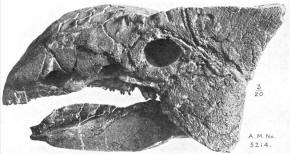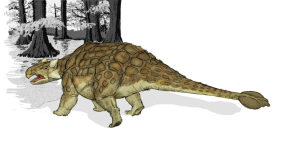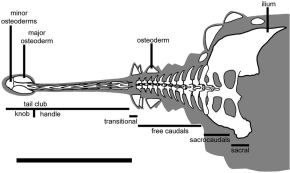|
Description
In comparison with modern land animals the adult
Ankylosaurus was
very large. Some scientists have estimated a length of 9 meters (30 ft).
Another reconstruction suggests a significantly smaller size, at 6.25 m
(20.5 ft) long, up to 1.5 m (5 ft) wide and about 1.7 m (5.5 ft) high at the
hip. Ankylosaurus may have weighed over 6,000 kilograms (13,000 lb).
The body shape was low-slung and quite wide. Ankylosaurus was
quadrupedal, with the hind limbs longer than the forelimbs. Although its
feet are still unknown, comparisons with other ankylosaurids suggest
Ankylosaurus probably had five toes on each foot. The
skull was low
and triangular in shape, wider than it was long. The largest known skull
measures 64.5 centimeters (25 in) long and 74.5 cm (29 in) wide.
Like other ankylosaurs,
 |
| Ankylosaurus skull |
Ankylosaurus was
herbivorous, with small, leaf-shaped teeth suitable for cropping
vegetation. These teeth were smaller, relative to the body size, than in any
other ankylosaurid species.
Ankylosaurus did not share the grinding tooth batteries of the
contemporaneous
ceratopsid and
hadrosaurid dinosaurs, indicating that very little chewing occurred.
Bones in the skull and other parts of the body were fused, increasing their
strength.
Armor
The most obvious feature of
Ankylosaurus is its armor, consisting
of massive knobs and plates of bone, known as
osteoderms or scutes, embedded in the skin. Osteoderms are also found in
the skin of
crocodiles,
armadillos and some
lizards.
The bone was probably overlain by a tough, horny layer of
keratin.
These osteoderms ranged greatly in size, from wide, flat plates to small,
round nodules. The plates were aligned in regular horizontal rows down the
animal's neck, back, and hips, with the many smaller nodules protecting the
areas between the large plates. Smaller plates may have been arranged on the
limbs and tail. Compared to the slightly more ancient ankylosaurid
Euoplocephalus, the plates of
Ankylosaurus were smooth in
texture, without the high keels found on the armor of the contemporaneous
nodosaurid
Edmontonia. A row of flat, triangular spikes may have protruded
laterally along each side of the tail. Tough, rounded scales protected the
top of the skull, while four large
pyramidal
horns projected outwards from its rear corners.
Tail club
The famous tail club of
Ankylosaurus was also composed of several
large osteoderms, which were fused to the last few tail
vertebrae. It was heavy and supported by the last seven tail vertebrae,
which interlocked to form a stiff rod at the base of the club. Thick
tendons
have been preserved, which attached to these vertebrae. These tendons were
partially ossified (or bony) and were not very elastic, allowing great force
to be transmitted to the end of the tail when it was swung. It seems to have
been an active defensive weapon, capable of producing enough of a
devastating impact to break the bones of an assailant.
A 2009 study showed that large tail knobs could generate sufficient force to
break bone during impacts, but average and small knobs could not, and that
tail swinging behavior is feasible in ankylosaurids, but it remains unknown
whether the tail was used for interspecific defense, intraspecific combat,
or both.
It has also been proposed that the tail club acted as a decoy for the head,
although this idea is now largely discredited.
Environment
Ankylosaurus magniventris was one of the dinosaurs to survive until
the Cretaceous-Tertiary extinction event. The
type specimen is from the
Hell Creek Formation of Montana, while other specimens have been found
in the
Lance Formation of
Wyoming
and the
Scollard Formation in
Alberta,
Canada, all
of which date to the end of the Cretaceous.
The Lance, Hell Creek and Scollard Formations represent different
sections of the western shore of the
shallow sea that divided western and eastern North America during the
Cretaceous. They represent a broad coastal plain, extending westward from
the seaway to the newly formed
Rocky Mountains. These formations are composed largely of
sandstone
and mudstone, which have been attributed to
floodplain environments.
The Hell Creek is the best studied of these ancient environments. At the
time, this region was
subtropical, with a warm and humid climate. Many plant species were
supported, primarily
angiosperms, with less common
conifers, ferns
and
cycads.
An abundance of fossil leaves found at dozens of different sites indicates
that the area was largely forested by small trees.
Fossils of
Ankylosaurus are considerably rare in these sediments,
compared to
Edmontosaurus and the super-abundant
Triceratops, which make up most of the large herbivore fauna.
Another ankylosaur, Edmontonia, is also found in the same formations.
However, Ankylosaurus and
Edmontonia seem to have been
separated both geographically and ecologically.
Ankylosaurus had a
wide muzzle, perhaps used for non-selective
grazing
and may have been limited to the upland regions, away from the coast, while
Edmontonia had a narrower muzzle, indicating a more selective diet,
and seems to have lived at lower elevations, closer to the coast.
Classification
Ankylosaurus was named as the
type genus of the family Ankylosauridae.
Ankylosaurids are members of the larger taxon Ankylosauria, which also
contains the
nodosaurids. Ankylosaur phylogeny is a contentious topic, with several
mutually exclusive analyses presented in recent years, so the exact position
of
Ankylosaurus within Ankylosauridae is unknown.
Ankylosaurus
and Euoplocephalus are often thought to be
sister taxa.
However, other analyses have found these genera in different positions.
Further discoveries or research may clarify the situation.
Discovery
Ankylosaurus was named by
American
paleontologist
Barnum Brown, in 1908. The generic name is derived from the
Greek words
αγκυλος/ankulos ('curved') and
σαυρος/sauros ('lizard'). Brown intended this
name in the same sense as the medical term
ankylosis,
to refer to the stiffness produced by the fusion of many bones in the skull
and body, so the name is often translated as 'stiffened lizard.' The
type species is
A. magniventris, from the
Latin
magnus ('great') and
venter ('belly'), referring to the great
width of the animal's body.
A team led by Brown discovered the type specimen of
A. magniventris
(AMNH 5895) in the Hell Creek Formation of Montana, in 1906. This
consisted of the top of the skull, as well as vertebrae, ribs, part of the
shoulder girdle and armor. Six years earlier, Brown found the skeleton of a
large
theropod dinosaur (AMNH 5866) in the Lance Formation of Wyoming.
This specimen was named Dynamosaurus imperiosus in 1905 but is now
thought to belong to
Tyrannosaurus rex. Associated with AMNH 5866 were more than 75
osteoderms of various sizes, which were attributed to
Dynamosaurus.
However, these osteoderms are nearly identical in form to those of
A.
magniventris and most probably belong to this species. In 1910, while on
an expedition to Alberta, Barnum Brown recovered his third specimen of
A.
magniventris (AMNH 5214), from the Scollard Formation. AMNH 5214
includes a complete skull and the first known tail club, as well as ribs,
limb bones and armor. All three of the above specimens are now housed at the
American Museum of Natural History in
New York City. The largest known skull of this animal (NMC 8880)
was collected in Alberta by
Charles M. Sternberg, in 1947 and is now housed at the
Canadian Museum of Nature. Many other isolated bones, armor plates and
teeth have been found over the years.
In popular culture
Since its description in 1908,
Ankylosaurus has been publicized as
the archetypal armored dinosaur, and due to its easily recognizable
appearance and the intense public interest in dinosaurs,
Ankylosaurus
has been a feature of worldwide popular culture for many years. A life-sized
reconstruction of Ankylosaurus featured at the
1964 World's Fair in New York City greatly contributed to its
popularity. Ankylosaurus has also been featured on several television documentary
miniseries, such as
Walking with Dinosaurs (1999) and
The Last Day of the Dinosaurs (2010).
If you ordered the Test Pack, it is now time to
take Test 7.
Return to the
Old Earth Ministries Online Dinosaur
Curriculum homepage.

Shopping
Bay
State Replicas - Skeleton (juvenile), skull, scutes, tooth with root
Black
Hills Institute - Shoulder spike
|


